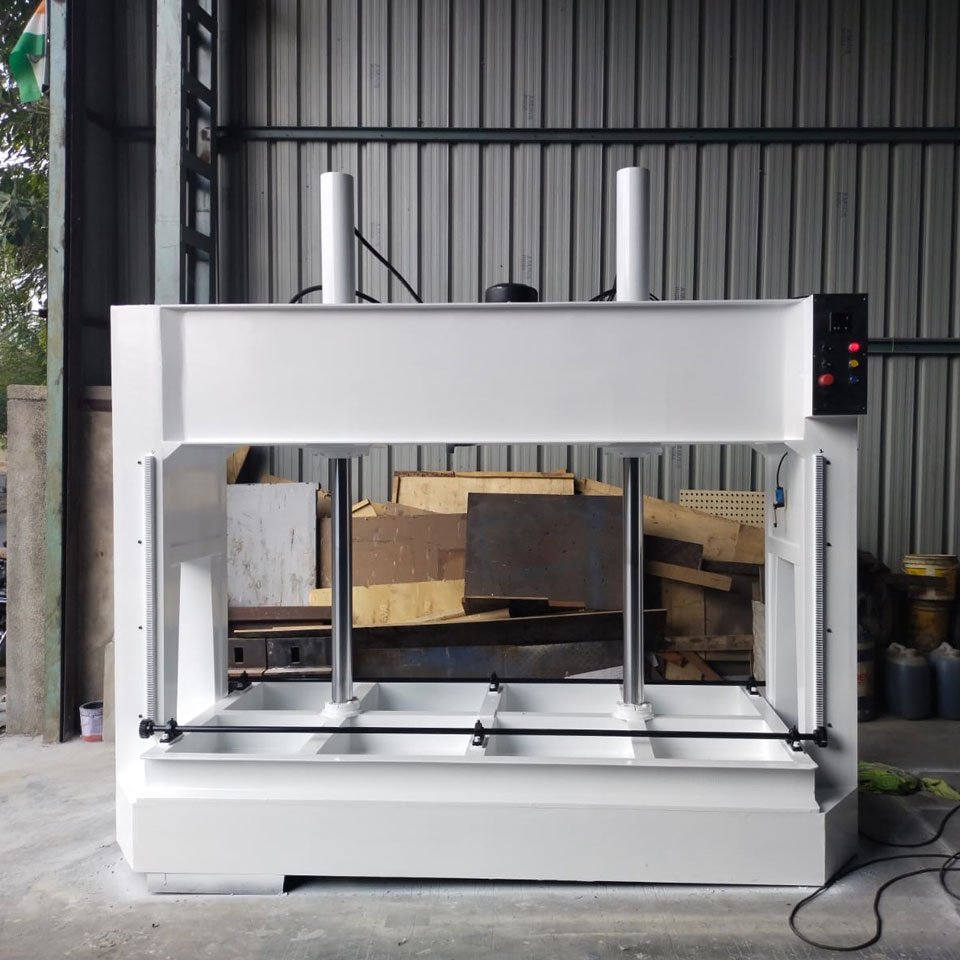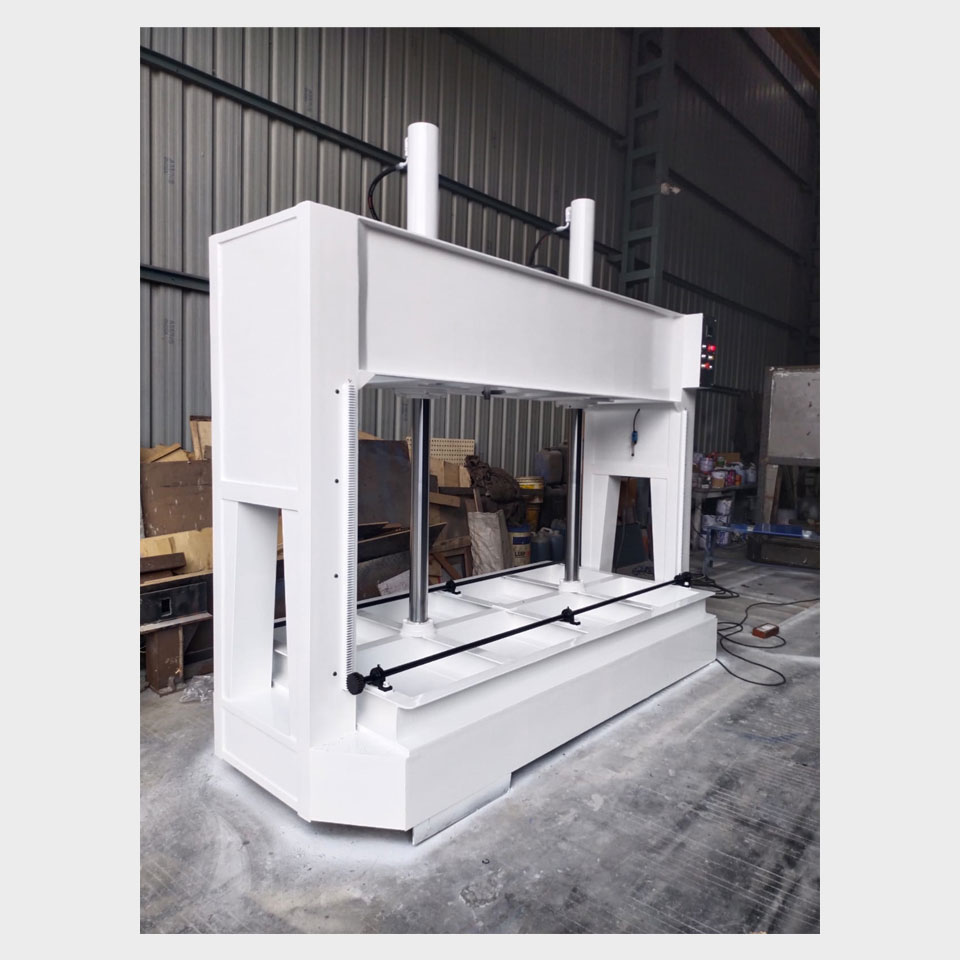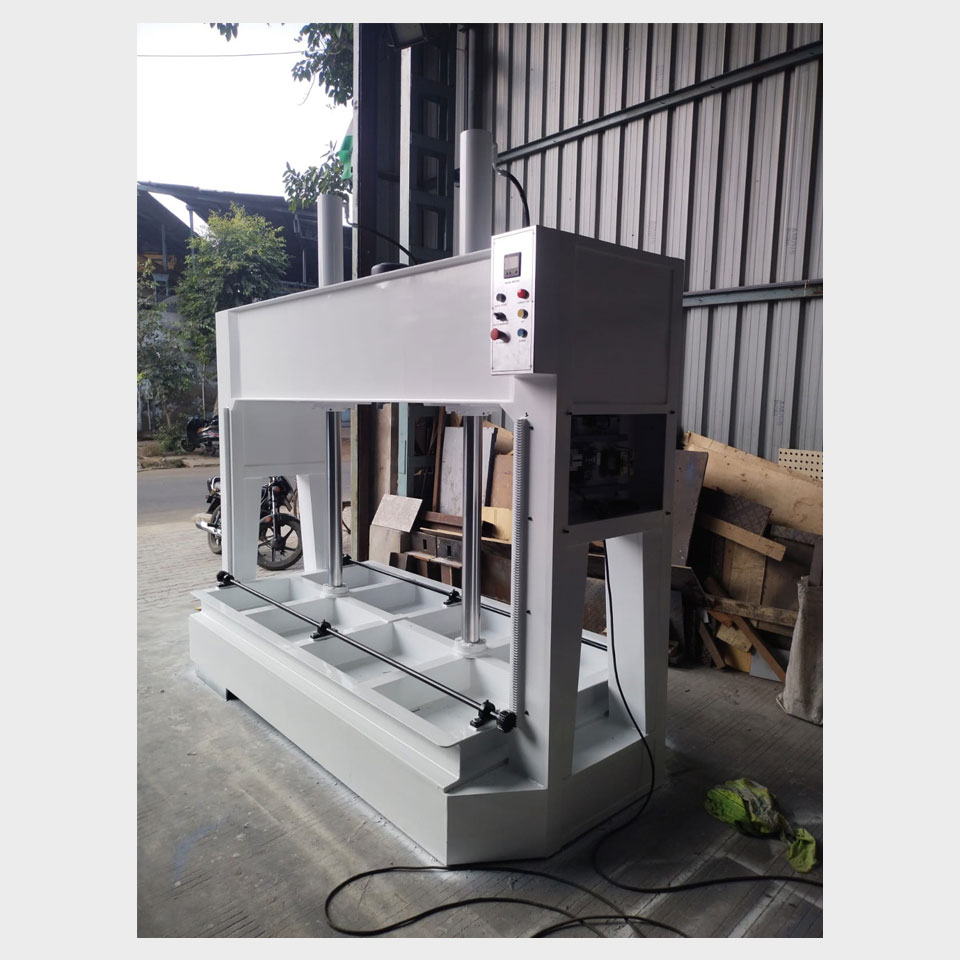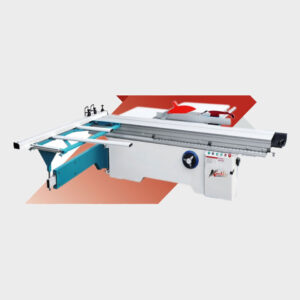| Description | FCP-50T | FCP-l00T |
|---|---|---|
| Working size | 2500xl300mm | 2500xl300mm |
| Max pressure | 50 Ton | 100 Ton |
| No of cylinders | 2 Nos | 4 Nos |
| Max opening | 1000mm | 1000mm |
| Cylinder stroke | 1000mm | 1000mm |
| Power req. | 5HP | 5HP |
| Overall dimension | 3000xl300x3050mm | 3000xl300x3050mm |
- Integrated with Digital Hydraulic meter with auto pressure control.
- Machine has two working modes: Auto Mode and Manual Mode.
- Designed to generate and handle uniform pressure.
- Operation cycle timer.
- All electrical parts are of standard company.
- All hydraulic parts are made with High Precision.
- Hydraulic cylinder with imported make seals.
The Silent Architect: Understanding the Cold Press in Woodworking
In the intricate world of woodworking, where precision, strength, and flawless finishes are paramount, the humble yet indispensable Cold Press stands as a silent architect of quality. While machines like panel saws and edge banders grab attention with their dynamic operations, the cold press works quietly, behind the scenes, to ensure the very foundation of many wood products: the perfect bond.
A cold press, in essence, is a hydraulic or mechanical machine designed to apply uniform pressure over a large surface area for an extended period, allowing adhesives to cure and create strong, permanent bonds between wood veneers, laminates, solid wood components, or composite materials. Unlike hot presses that use heat to accelerate adhesive curing, cold presses rely solely on sustained pressure, making them ideal for a wider range of glues and materials sensitive to heat.
The Indispensable Role of the Cold Press
The strength and integrity of many wood products hinge directly on the quality of their bonding. Whether it’s creating a veneered panel, laminating multiple layers for thickness, or joining large solid wood sections, consistent and sustained pressure is non-negotiable. Without it, bonds can be weak, uneven, or prone to delamination, leading to product failure and significant material waste.
Here’s why the cold press is indispensable in modern woodworking:
- Superior Bond Strength: By applying uniform and consistent pressure over a prolonged period, cold presses allow adhesives (especially those that cure slowly at room temperature, like PVA, Urea-Formaldehyde, or Epoxy) to penetrate deeply into the wood fibers and form exceptionally strong, durable bonds.
- Dimensional Stability: Laminating multiple layers of wood or applying veneers helps to balance the inherent stresses in wood, leading to more dimensionally stable panels that are less prone to warping, twisting, or cupping.
- Material Versatility: Cold presses can bond a wide array of materials, including thin veneers, high-pressure laminates (HPL), plywood, MDF, particle board, solid wood, and even certain plastic or composite overlays.
- Cost-Effectiveness: Compared to hot presses, cold presses generally have lower initial costs and consume less energy as they don’t require heating elements. They also allow for the use of more economical, slower-curing adhesives.
- Finish Quality: A perfectly pressed panel or veneered surface is flat, smooth, and free of bubbles or delaminations, providing an ideal base for subsequent finishing processes like sanding, painting, or polishing.
How a Cold Press Works
The fundamental principle behind a cold press is simple: apply and maintain uniform pressure. This is typically achieved through a hydraulic system.
- Loading: The materials to be bonded (e.g., a substrate panel, glue, and a veneer sheet) are carefully stacked onto the press’s lower platen.
- Pressure Application: Hydraulic cylinders push the upper platen down onto the materials. The number and arrangement of cylinders are crucial for ensuring even pressure distribution across the entire surface.
- Pressure Maintenance: Once the desired pressure is reached (measured in tons or kg/cm²), it is maintained for a specific duration, known as the “pressing time.” This time allows the adhesive to cure fully at ambient temperature.
- Unloading: After the curing time, the pressure is released, and the perfectly bonded panel is removed.
Key Features of a Modern Cold Press
While the basic principle remains, modern cold presses incorporate several features to enhance efficiency, versatility, and ease of use:
- Robust Steel Frame: The entire structure is built from heavy-duty welded steel to withstand immense pressure without deflection, ensuring consistent flatness of the pressed panels.
- Hydraulic System: Comprises a powerful hydraulic pump, a motor, hydraulic cylinders, and a control manifold. The quality of these components directly impacts the press’s reliability and pressure consistency.
- Platens: The top and bottom pressing plates (platens) are typically machined from thick steel or engineered material to ensure perfect flatness and even pressure distribution. Sizes vary widely to accommodate different panel dimensions.
- Cylinder Configuration: Multiple hydraulic cylinders are strategically placed across the platen to distribute pressure uniformly, preventing weak spots or “doming” in the middle of large panels.
- Pressure Adjustment: Operators can precisely set the desired pressing pressure, usually displayed on a pressure gauge, ensuring optimal bonding for different materials and adhesives.
- Timer Controls: An integrated timer allows for precise setting of the pressing duration, ensuring adequate curing time for the adhesive. Some advanced models might have programmable timers for multiple cycles.
- Safety Features: Essential safety measures include emergency stop buttons, safety light curtains, pressure relief valves, and automatic shut-off systems to protect operators.
- Roller Tables/Conveyors (Optional): For larger presses or high-volume operations, integrated roller tables or conveyor systems can facilitate easy loading and unloading of heavy panels, improving workflow efficiency.
- Daylight Opening Adjustment: The maximum vertical opening between the platens can often be adjusted to accommodate varying stack heights of materials.
Applications in Woodworking
The versatility of the cold press makes it invaluable across numerous woodworking applications:
- Veneering: Applying decorative wood veneers to substrate panels (plywood, MDF, particle board) for furniture, doors, wall panels, and architectural millwork. This is perhaps its most common and crucial application.
- Laminating: Bonding high-pressure laminates (HPL) or other decorative plastic laminates onto panels for countertops, cabinet doors, office furniture, and retail fixtures.
- Panel Gluing/Solid Wood Gluing: Gluing together smaller strips or sections of solid wood to create wider panels (e.g., for tabletops, door panels, or custom dimension lumber).
- Composite Material Bonding: Pressing various layers of composite materials together to form strong, stable sheets.
- Plywood Manufacturing (Small Scale): While large-scale plywood production uses specialized multi-opening presses, smaller cold presses can be used for custom or specialized plywood lamination.
- Door Manufacturing: Pressing door skins onto door cores.
Benefits of Investing in a Cold Press
For any serious woodworking operation, a cold press offers significant advantages:
- Unrivaled Bond Quality: Guarantees strong, uniform, and long-lasting bonds that prevent delamination and enhance product durability.
- Flawless Finish: Creates perfectly flat and smooth surfaces, free from bubbles or wrinkles, which are critical for subsequent finishing processes.
- Increased Productivity: While the pressing time itself can be long, a cold press allows multiple panels to be prepared and loaded simultaneously, and once loaded, the operator is free to prepare the next set of materials. For businesses with limited space, a single press can handle a significant volume of work over a day.
- Material Versatility: Broad compatibility with various adhesives and wood-based materials expands the range of products a workshop can offer.
- Cost-Effective Operation: Lower energy consumption and the ability to use economical adhesives contribute to reduced operational costs compared to hot presses.
- Improved Efficiency: Reduces rework and material waste caused by poor bonding, saving both time and resources.
- Safety: Modern cold presses are designed with multiple safety features, making them safer to operate than manual clamping methods for large panels.
Choosing the Right Cold Press
Selecting the ideal cold press for your woodworking operation requires careful consideration:
- Platen Size: This is arguably the most critical factor. Determine the maximum dimensions of the panels or components you will be pressing. Common sizes include 4×8 feet, 5×10 feet, or even larger custom sizes. Ensure the press size can comfortably accommodate your largest workpieces.
- Pressure Capacity: Assess the maximum pressure required for your applications. This is usually rated in tons. Veneering often requires less pressure than laminating thick solid wood sections.
- Daylight Opening: Consider the maximum stack height you’ll typically be pressing. This dictates the vertical clearance between the platens.
- Number and Arrangement of Cylinders: More cylinders, strategically placed, generally mean better and more uniform pressure distribution.
- Hydraulic System Quality: Look for reputable brands for the pump, motor, and valves, as these are the heart of the press.
- Frame Construction: A robust, heavy-duty frame is essential for long-term stability and consistent performance without deflection.
- Controls and Features: Assess whether you need basic pressure and timer controls or more advanced features like roller tables, multiple platen openings, or integrated material handling.
- Budget: Cold presses vary significantly in price based on size, capacity, and features. Balance your budget with your long-term production needs and expected return on investment.






There are no reviews yet.